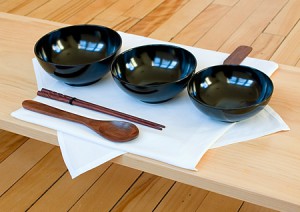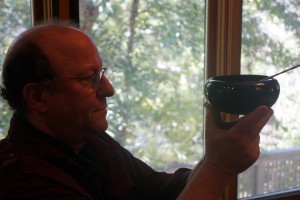Wednesday
Community ArticlesVajradhatu Oriyoki
An interview with Oriyoki Master, Roland Cohen
by Judy Sachs Sullivan, Column Co-Host
Judy: Roland, can you talk about how oriyoki was first introduced to the Vidyadhara, Chogyam Trungpa Rinpoche and to the Vajradhatu sangha?
Roland: The Vidyadhara sent out a formal request to Kobun Chino Sensei back around 1979/80 to give our community the oriyoki practice. We received this practice from Kobun Chino through Mipham Halpern and this in turn was presented to our sangha.
Years after receiving this practice, I had the opportunity to speak with Sensei directly and found out that he had to think about this request at the time, as this was a major decision for him. Giving the oriyoki practice transmission was not a small request. Once transmitted, the Vidyadhara entrusted the then Sawang with holding the oriyoki practice, so he was in charge of this in the community. Our form of oriyoki comes from the Zen tradition and is the most formal form of oriyoki. At the time we received this practice we did not know of all the various forms out there in the Zen tradition. The Vidyadhara loved the details of Oriyoki practice.
Judy: What else did Kobun Chino say about this practice?
Roland: Kobun Chino said that when you first pick up your oriyoki set above your head level, that your attitude should be as if you are receiving it directly from the Buddha. He also said that the Buddha bowl is viewed as the Buddha’s skull. In 1988/89 at Warrior’s Assembly, Kobun Chino Sensei was the guest of honor for an oriyoki meal. To my surprise, he received all his food (all 3 dishes) in his one Buddha bowl. This was totally different from how we had been practicing oriyoki, as we always used all 3 bowls, one for each dish. Our Vajradhatu version was very strict in terms of ‘rules’, as well as our logic about how and why things were done in oriyoki. Later, I had the chance to speak with Espe Brown (renowned Zen cook), who said that they ‘cheated’ all the time in the way oriyoki was practiced.
Judy: Can you tell me a little about the Vajradhatu history of oriyoki once it was presented?
Roland: The 1980 seminary was the first formal introduction to Oriyoki, and this was taught by Charles Zimmerman (Lady Rich’s brother). He then went on to teach me. Then in 1981, Bob Salskov and I formed the oriyoki committee and we worked on aligning the details of the physical practice of oriyoki with the liturgy and offerings. We had the Japanese form of oriyoki, the physical details of how you practice and the attitudes that go along with that, but the liturgy we used was Tibetan. The Tibetan liturgy we recite in oriyoki is the “Sutra of the Recollection of the 3 Jewels.”
Judy: How does Oriyoki affect the type of food that is cooked and served?
Roland: The lunch meal at seminary was the time we did the full oriyoki practice and liturgy. The Buddha bowl always had a grain dish, such as rice, pasta, barley, etc. The second bowl always had a soup, usually a miso soup with some tofu. Finally, the third bowl contained the protein dish, usually a stir fry. The pieces had to be cut small enough so that they could be picked up with chopsticks. Then during the service, condiments would be passed down each row of participants. I remember that at the 1981 seminary, the kitchen had totally undercooked the barley that was served during oriyoki. The barley was like rubber and completely inedible. I was umdze that day and everyone was hysterical with laughter. Everyone ended up having huge offerings of barley, because they couldn’t possibly eat it!Judy: Can you give a brief explanation of what oriyoki looks like?
Roland: The oriyoki set comes with 5 nested bowls. Traditionally practitioners had black laquer bowls and the roshi would have reddish-orange laquer bowls, which is what the Vidyadhara used. It took a while for Vajradhatu to find someone to make the laquer sets, so many initially used the black plastic oriyoki sets. All our cloths were navy blue in color. The bowls sat in the middle of the base serviette, then a rectangular napkin sat atop of the set of bowls. The setsu case (which looks like a cloth pencil case, contains the chopsticks and wooden spoon), and this sits atop the napkin-like cloth. In the fold of the opening of this setsu sits the bamboo stick with a cloth tip used for cleaning the bowls. The wipe serviette is used to dry the bowls. We had a calligraphy cloth that sat on top. In learning oriyoki it seems like there are so many rules, but once you have practiced it you find that it becomes part of you. In Japan, many of these rules are just part of their everyday way of eating.
Judy: How is oriyoki a meditation practice?
Roland: Mindfulness is a big part of oriyoki. Sitting up straight, holding the bowls correctly, and not making noise when you eat are part of the practice. The Vidyadhara gave many talks at the 1980/81/82 seminaries about oriyoki and working with food neurosis. In oriyoki you take what is served and you eat all of it. This goes back to the begging bowl of the Buddha, where you accept whatever is given. The whole way you eat the meal includes the attitude that you are including all sentient beings, so oriyoki is also a Mahayana practice.
Roland Cohen feels that there is very much a strong transmission quality to oriyoki and how we practice it. He hopes to someday write a small manual about the practice and history of the Vajradhatu style of Oriyoki.
To read other entries in this column, please see: Kitchen Wisdom.
 ~~
~~
Judy Sachs Sullivan is a personal chef, cook, food writer and recipe writer. She hopes this column will help preserve some of the history and stories of the Vidyadhara and Vajradhatu in how it pertains to food and meditation.



















Jul 16, 2015
Reply
At the 1981 Seminary I was posted to guard the dining room after lights out. At about 2 a.m. the Vidyadhara came in with several others. A few lights were turned. He sat on a cushion and had his oryoki set laid out. For about an hour his attendants came in to offer food (there was no food – it was practice). The Vidyadhara would try different forms, when to bow, whether to hold chopsticks with particular bowls or not, and so on. At the end as the Vidyadhara stood up from his seat he said “We have about 500 years to get this right.”
Jul 15, 2015
Reply
How is Vajradhatu oryoki different from Shambhala oryoki?